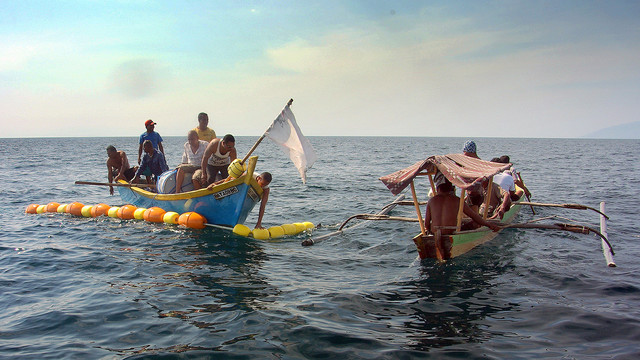Investing in hilsa fishery as economic infrastructure for Bangladesh
Hilsa fishery is highly valuable to Bangladesh, and anecdotal evidence suggests that the use of economic incentives to manage the fishery has had positive social and ecological outcomes. This project aimed to estimate the true economic value of hilsa fishery and rigorously assess the impact of the economic incentive mechanism.

Of the total catch of fish produced in Bangladesh each year, 11% is hilsa (Tenualosa ilisha). Around 287,000 fishers depend directly on fishing hilsa for their livelihood and an estimated 2–2.5 million people are involved in activities throughout the supply chain – transportation, marketing, processing, and other post-harvest activities.
Hilsa is the 'national fish' of Bangladesh – it is the fish of choice for most people and is of both religious and cultural importance.
Once abundant in Bangladesh's 100 rivers, hilsa was widely caught by fishers to sell to local and urban markets. But hilsa production began to decline in the 1970s, reaching an all-time low of just 0.19 million tonnes in 2001-02.
The fall in production prompted the Bangladeshi government to ringfence five sites in the country's coastal rivers as hilsa 'sanctuaries', where fishing is restricted during the breeding season.
To compensate for loss of earnings, the government began providing affected fishing communities with rice and alternative income-generating activities. This compensation scheme was meant to both offset the short-term cost of fishing restrictions, and induce behavioural change by incentivising fishers to change their unsustainable fishing practices.
What did IIED do?
As part of the effort to enhance the effectiveness of the incentive-based management scheme and make the case for an increased investment in the sector, the IIED and the Bangladesh Centre for Advanced Studies (BCAS), in partnership with the WorldFish Centre, worked to fill the knowledge gap on:
- Estimating the economic value of hilsa fishery
- Examining both social and ecological impacts of the incentive-based scheme, and
- Assessing the profitability, power structures, financing opportunities and systemic constraints along the supply chain.
This work contributed to the overall objective of the USAID-funded EcoFishBD project which was designed to improve resilience and governance of the Padma-Meghna river-estuarine ecosystem and livelihoods of communities reliant on hilsa fisheries. It was managed by the WorldFish Center.
The approach
The research team generated information to inform the decision-making process through:
- Unearthing the hidden value of hilsa
It is estimated that hilsa makes up one per cent of Bangladesh's gross domestic product (Wahab et al. 2014). But the true economic value of hilsa fishery is likely to be much higher.
Because hilsa fishing is largely informal, markets do not easily capture its true monetary and non-monetary values and the sector remained poorly accounted for in national accounts. As a result – despite the government's efforts to promote it – it was rarely given the attention it deserves in policy decisions about economic development, poverty alleviation, food security, conservation or environmental sustainability.
An explicit understanding of the total economic value of hilsa fisheries is needed to stop the sector being overlooked or underestimated in decision-making processes. There had been no study done to estimate the sector's total economic value, yet such an accurate estimate would equip policymakers with the evidence needed to adequately invest in developing hilsa fishery as an economic infrastructure.
We estimated both the use (consumptive) and non-use (non-consumptive) values of hilsa fishery.
- Evaluating the impact of the compensation scheme
Anecdotal evidence suggested that the compensation scheme has had positive impacts both on hilsa population and the livelihoods of thousands of fishers. But there had been no rigorous impact evaluation – and researchers agreed that one was sorely needed. A properly designed impact evaluation was particularly important because it would show whether the intervention was working or not, and could be used to inform decisions about scaling up.
In thinking about how to evaluate impacts, it is important to distinguish between the monitoring of outcomes, which is a description of the factual; and the use of 'counterfactuals'; to attribute observed outcomes to the intervention.
Like many developing world fisheries, Bangladesh's hilsa fishing is characterised by limited data. We used an 'ex-post' impact evaluation technique, such as 'propensity score matching'. We assessed the scheme's impacts in three main areas: 1) livelihoods/poverty alleviation; 2) ecology or hilsa population and biodiversity in general; and 3) local economy – such as food price and labour market distortions.
- Harnessing market forces to ensure sustainable financing
One of the most important factors that will help or hinder the compensation scheme's sustainability is continued financing. In this project, we used value/supply chain analysis to map key actors (both formal and informal) enabling factors, and systemic constraints such as access to microcredit and other key services. We also assessed power structures and profitability among different stakeholders to identify features that limit net returns by hilsa fishers.
Finally, we mapped direct beneficiaries along the supply chain (including fish processors, exporters, service providers and so on) and explored the potential of introducing a service fee (payment) as an alternative financing mechanism.
News and updates
Publications
Additional resources
Power, profits and payments for ecosystem services in Hilsa fisheries in Bangladesh: a value chain analysis, Ina Porras, Essam Yassin Mohammed, Liaquat Ali, Md. Shahajat Ali, Md. Belayet Hossain (2017), article in the journal Marine Policy, Elsevier







